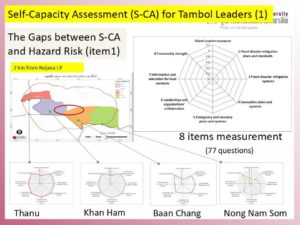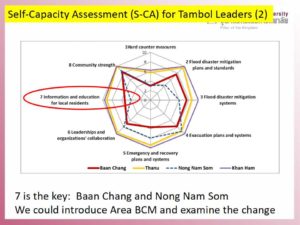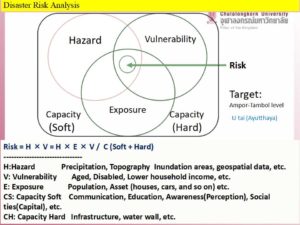
Image Source: Unsplash
This article is prepared based on the recent flood to understand the flood management status in Italy.
https://www.youtube.com/watch?v=nHgTocw3Ogs
Italy, a country renowned for its captivating aesthetics and profound cultural legacy, confronts a mounting predicament as the water levels surge, jeopardizing its architectural wonders and the routine existence of its populace. The acceleration of climate change has resulted in the nation grappling with the adverse impacts of devastating floods that cause significant damage to its scenic cities and towns. This article delves into the multifaceted challenges posed by floods in Italy, exploring the underlying complexities of the issue and highlighting creative approaches that are transforming the nation’s trajectory. Italy is making strides toward preserving its legacy for future generations by utilizing advanced technology, implementing community-based strategies, and demonstrating an unwavering commitment to environmental sustainability. Embark with us on an enlightening expedition as we delve into the unyielding struggle against the advancing waters and commemorate the achievements of human innovation and resilience in the midst of hardship.
The Impact of Climate Change on Italy’s Flood Risks
The phenomenon of climate change has had a significant impact on the global environment, including Italy. The escalation of global temperatures has resulted in an augmented peril of floods within the nation, which could potentially culminate in disastrous results. The increase in temperature has been found to have a significant impact on the melting of glaciers in the Alps. This phenomenon has been observed to result in a rise in sea levels and an increase in the volume of water in rivers and lakes. The excess of water increases the susceptibility to floods, especially in the coastal regions of Italy that are situated at lower elevations.
Furthermore, the phenomenon of climate change has led to an increase in the frequency and intensity of extreme weather occurrences, including but not limited to heavy precipitation and storms. The occurrence of heavy rainfall can result in the inundation of drainage systems and the emergence of flash floods, which pose a significant threat to urban regions. The impact of climate change on flood risks in Italy is a critical issue that requires comprehensive understanding and innovative solutions to be tackled.
Italy has exhibited a resolute dedication to mitigating its flood hazards, despite the adversities presented by climate change. In recent decades, the nation has made noteworthy progress in comprehending the origins and consequences of floods, while also executing effective measures for prevention and reduction. The forthcoming sections will examine the historical occurrences of floods in Italy, the underlying factors that contribute to its susceptibility to flooding, and the pioneering measures that are shaping a more secure and robust future.
Historical Floods in Italy: Lessons Learned and Progress Made
Italy boasts a rich historical record of disastrous floods that have inflicted enduring damage upon its terrain and populace. In 1966, the Arno River in Florence experienced a catastrophic flood that resulted in the loss of over 100 lives and extensive damage to numerous works of art and cultural artifacts. This event has become widely recognized as one of the most infamous floods in history. The aforementioned calamitous incident acted as a stimulus for the country and instigated a revitalized emphasis on flood prevention and readiness.
Subsequent to the Florence flood, Italy encountered a multitude of consequential flood occurrences. The Piedmont region experienced a catastrophic flood in 1994, resulting in extensive devastation and loss of human lives. In 2011, Genoa experienced a flash flood that resulted in the loss of six lives and significant harm to infrastructure. The aforementioned calamitous incidents have underscored the necessity for effective flood management strategies, prompting the Italian authorities to allocate resources towards scholarly inquiry, enhancements in infrastructure, and pioneering approaches aimed at mitigating the hazards associated with flooding.
Italy has achieved significant advancements in comprehending its flood hazards and executing strategies to avert and reduce their consequences, owing to these endeavors. The nation has implemented advanced flood forecasting and early warning mechanisms to furnish prior intimation of potential flood incidents, thereby empowering communities to make adequate preparations and respond with greater efficacy. Moreover, Italy has made significant investments in enhancing its infrastructure, including the development of dams, levees, and drainage systems, with the aim of providing greater protection to regions that are susceptible to flooding. Despite notable advancements, there remains a substantial amount of work to be undertaken in order to guarantee the safety and fortitude of Italy’s populace in light of the escalating threat of flooding.
Factors Contributing to Italy’s Flood Vulnerability
Italy’s susceptibility to floods can be attributed to a combination of factors, such as its distinctive geography, urbanization, and land-use practices. The nation’s vast expanse of coastal areas and multiple waterways provide it especially vulnerable to inundation caused by both coastal storms and riverine deluges. Furthermore, the topography of Italy is distinguished by steep mountainous regions and narrow valleys, which can intensify the probability of flooding by directing water towards densely inhabited regions and enhancing the possibility of landslides.
The surge in urbanization and alterations in land use has been instrumental in enhancing Italy’s susceptibility to flooding. The expansion of urban areas results in the replacement of natural landscapes with impervious surfaces, such as buildings, roads, and parking lots, that hinder the infiltration of water into the ground. Consequently, there is a rise in surface runoff and an enhanced susceptibility to flooding in the occurrence of intense precipitation episodes. Moreover, the development of infrastructure in regions susceptible to flooding has increased the vulnerability of both individuals and resources, thereby exacerbating the potential consequences of a flood occurrence.
Italy’s susceptibility to floods can also be attributed to insufficient maintenance of flood defense infrastructure, including levees, dams, and drainage systems. Insufficient investment in maintenance and aging infrastructure can result in the failure of crucial systems during critical times, thereby endangering lives and property. It is imperative to consider these factors in order to mitigate flood hazards in Italy and establish a future that is more resilient.
Innovative Flood Management Solutions in Italy
Italy has adopted a multifaceted approach to address the intricate issues posed by flooding, which integrates conventional flood protection strategies with state-of-the-art technology and environmentally conscious methodologies. The proposed solutions endeavor to mitigate the underlying factors that contribute to susceptibility to flooding, while simultaneously advocating for ecological sustainability and adaptability.
The implementation of green infrastructure within urban environments represents a viable strategy. Green infrastructure applies to the utilization of natural or semi-natural mechanisms, such as green roofs, parks, and permeable pavements, for the purpose of effectively handling stormwater and mitigating the likelihood of flooding. The aforementioned characteristics not only facilitate the assimilation and absorption of surplus water but also result in dramatic ecological and communal advantages, including reduced atmospheric conditions, diminished urban heat island consequences, and enhanced biodiversity.
An additional inventive approach involves the adoption of flexible and adaptable flood control tactics that can adapt to fluctuating circumstances and ambiguities. The MOSE project, a system of mobile barriers, has been developed by the city of Venice to safeguard the city from the negative impacts of rising sea levels and storm surges. The barriers possess the capacity to be adjusted in accordance with the varying flood risks, thereby facilitating a flexible approach while mitigating the adverse effects on the city’s fragile ecosystem and heritage edifices.
Urban Planning and Design for Flood Resilience
Apart from pioneering flood management strategies, Italy has acknowledged the significance of urban planning and design in advancing flood resilience. The incorporation of flood risk assessments into the planning and development process can enhance the resilience of urban and rural areas to floods and facilitate their adaptation to the dynamic climate.
The identification and preservation of natural floodplains is a crucial element in urban planning strategies aimed at enhancing flood resilience. The aforementioned regions, which exhibit susceptibility to inundation in the event of heavy precipitation, play a pivotal role in affording storage and absorption capacity for surplus water. Through the preservation of these regions and the imposition of development restrictions within them, communities can mitigate their exposure to flood hazards while simultaneously safeguarding crucial ecosystem services and habitats for wildlife.
Another important consideration is the integration of flood risk management into the design of buildings and infrastructure. Potential strategies for mitigating flood risks may involve implementing techniques such as raising structures to exceed projected flood levels, utilizing materials and construction methods that are resistant to flooding, and creating adaptable spaces that can serve a variety of purposes, such as temporary flood storage or evacuation facilities. Through the integration of these design principles, communities have the ability to mitigate the potential adverse impacts and disturbances resulting from flooding while simultaneously strengthening their overall capacity for resilience.
The Role of Nature-Based Solutions in Flood Mitigation
In contemporary times, there has been a growing interest in nature-based solutions (NBS) as a practical and economical strategy for mitigating floods. The aforementioned solutions utilize natural processes and ecosystems to mitigate flood hazards through restoration, preservation, or enhancement. Instances of Nature-Based Solutions (NBS) encompass the rehabilitation of wetlands and floodplains, afforestation of slopes, and establishment of green areas in urban settings.
Several NBS (Nature-Based Solutions) initiatives have been successfully executed in Italy, exhibiting encouraging outcomes. The “Life-Envi-Med” initiative, located in the Sardinia region, aims to mitigate flood hazards and foster biodiversity by rehabilitating and safeguarding coastal dunes and wetlands. An additional instance is the “Vallevecchia” initiative located in the Veneto region, with the objective of rehabilitating prior farmland to establish a natural barrier area that can assimilate floodwaters and offer significant habitat for fauna.
Through the implementation of Nature-Based Solutions (NBS), Italy is able to mitigate the potential hazards of flooding while simultaneously demonstrating its dedication to the principles of ecological sustainability and the preservation of biodiversity. Moreover, Natural Based Solutions (NBS) frequently offer supplementary advantages, such as improved water quality, heightened recreational possibilities, and enhanced climate change adaptability, rendering them a valuable constituent of Italy’s comprehensive flood management approach.
Technological Advancements in Flood Forecasting and Early Warning Systems
The utilization of technology is of utmost importance in Italy’s endeavors to effectively mitigate flood hazards and strengthen its capacity to adapt to adverse circumstances. The implementation of flood forecasting and early warning systems has played a crucial role in mitigating the adverse effects of floods on both human settlements and physical infrastructure.
The National Early Warning System for Hydrogeological and Hydraulic Risks (SINIFF) is a noteworthy instance of technological advancement, which was established through a joint venture between the National Civil Protection Department of Italy and the regional environmental protection agencies. SINIFF integrates contemporaneous data from monitoring stations with sophisticated hydrological and meteorological models to furnish prompt and precise flood prognostications and notifications. The aforementioned data empowers regional governing bodies and first responders to adopt preemptive measures aimed at safeguarding human lives and assets, including but not limited to the evacuation of inhabitants, road closures, and fortification of flood barriers.
Apart from SINIFF, various early warning systems at regional and local levels have been formulated to cater to distinct flood hazards and susceptibilities. The Piedmont region has incorporated a sophisticated flood prediction system that integrates current information from river monitoring stations, weather radar data, and hydrological models to predict potential flood occurrences. Through the utilization of technological advancements, Italy can enhance its ability to forecast and address flood hazards, leading to a reduction in the adverse impact on both human life and economic resources caused by such disasters.
Community Engagement and Collaboration in Italy’s Flood Management
Effectively addressing the complex problems related to flood management necessitates the involvement and cooperation of various entities, such as government agencies, scholars, enterprises, and nearby populations. Italy has adopted a participatory strategy for flood management, prioritizing the involvement of all pertinent stakeholders in the decision-making process and promoting a collective sense of accountability for mitigating flood risks.
An instance of community involvement in flood management is the formation of regional flood committees, which convene delegates from diverse sectors to formulate and execute strategies for managing flood risks. The aforementioned committees serve as a platform for various stakeholders to exchange information, collaborate on initiatives, and devise novel approaches to address flood-related issues at the local level.
Additionally, Italy has acknowledged the significance of public education and awareness in advancing flood resilience. The National Flood Awareness Campaign is an endeavor that seeks to disseminate knowledge and provide instruction to individuals regarding the hazards of flooding and the actions they can undertake to safeguard themselves and their localities. Italy is fostering a culture of resilience and enhancing its capacity to adapt to the evolving climate by equipping individuals and communities with knowledge and skills.
The implementation of collaborative efforts and partnerships is deemed essential in Italy’s flood management endeavors. The nation has forged collaborations with global organizations, such as the European Union, to exchange knowledge and proficiency and acquire financial resources for inundation control initiatives. Furthermore, Italy has engaged in cooperative efforts with its adjacent nations, including France and Switzerland, to tackle the issue of cross-border flood hazards and establish collective flood control strategies.
It is imperative that Italy takes measures to enhance its flood management capabilities to safeguard its future.
The current situation in Italy highlights the necessity for a holistic and cohesive strategy toward flood control and mitigation. Italy can enhance its flood risk mitigation strategies by integrating traditional flood defense measures with innovative methods such as green infrastructure, adaptive flood management, and nature-based solutions, thereby fostering ecological sustainability and resilience.
In addition, it is imperative that Italy involves all pertinent parties such as governmental entities, scholars, enterprises, and nearby communities in the process of making decisions and cultivates a mindset of fortitude and cooperation. Through collaborative efforts, Italy has the potential to construct a more secure and durable future for its populace while safeguarding its cultural legacy for future generations.
Italy’s ability to overcome challenges related to climate change and flooding is noteworthy, given its history of resilience and innovation, which serves as a source of inspiration and optimism. Italy is able to overcome these challenges and establish a more sustainable future by persisting in its investment in flood management strategies and adopting innovative ideas and technologies.













